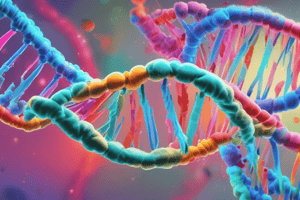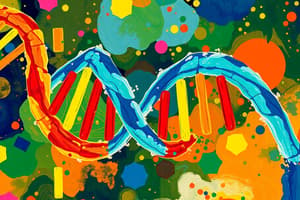Podcast
Questions and Answers
What type of DNA molecules can DNA ligase catalyze during the joining reactions?
What type of DNA molecules can DNA ligase catalyze during the joining reactions?
- Only blunt-ended molecules
- Neither blunt-ended nor sticky-ended molecules
- Both blunt-ended and sticky-ended molecules (correct)
- Only sticky-ended molecules
What is a common method to create sticky ends on blunt-ended DNA fragments?
What is a common method to create sticky ends on blunt-ended DNA fragments?
- Using single-stranded DNA
- Employing polymerase chain reaction
- Incorporating linkers (correct)
- Using heat denaturation techniques
What characteristic do linkers possess that allows them to be attached by DNA ligase?
What characteristic do linkers possess that allows them to be attached by DNA ligase?
- They are naturally occurring within cells
- They have complementary sticky ends
- They are produced exclusively in vivo
- They contain known nucleotide sequences and a restriction site (correct)
During gene cloning, what is a potential issue when using a vector with sticky ends but blunt-ended DNA fragments?
During gene cloning, what is a potential issue when using a vector with sticky ends but blunt-ended DNA fragments?
What is the role of a common restriction site in the use of linkers?
What is the role of a common restriction site in the use of linkers?
What is the primary purpose of using linkers in DNA modification?
What is the primary purpose of using linkers in DNA modification?
What happens when a blunt-ended DNA molecule contains BamHI recognition sequences during the restriction step?
What happens when a blunt-ended DNA molecule contains BamHI recognition sequences during the restriction step?
What is one drawback of using linkers to attach sticky ends?
What is one drawback of using linkers to attach sticky ends?
How do adaptors differ from linkers in their function?
How do adaptors differ from linkers in their function?
What is produced after BamHI cleaves the chains at the recognition sequences?
What is produced after BamHI cleaves the chains at the recognition sequences?
What is required for two blunt-ended DNA molecules to ligate after the addition of adaptors?
What is required for two blunt-ended DNA molecules to ligate after the addition of adaptors?
What characterizes a homopolymer?
What characterizes a homopolymer?
Why is it important for poly(dG) and poly(dC) tails to be complementary?
Why is it important for poly(dG) and poly(dC) tails to be complementary?
What is the first step in repairing nicks in recombinant DNA that has undergone homopolymer tailing?
What is the first step in repairing nicks in recombinant DNA that has undergone homopolymer tailing?
How does terminal deoxynucleotidyl transferase contribute to the creation of sticky ends?
How does terminal deoxynucleotidyl transferase contribute to the creation of sticky ends?
What might happen if the poly(dG) and poly(dC) tails are not the same length?
What might happen if the poly(dG) and poly(dC) tails are not the same length?
What is the role of Klenow polymerase in the repair reaction following homopolymer tailing?
What is the role of Klenow polymerase in the repair reaction following homopolymer tailing?
If the complementary homopolymer tails are longer than approximately 20 nucleotides, what is the outcome?
If the complementary homopolymer tails are longer than approximately 20 nucleotides, what is the outcome?
What is the primary role of DNA ligase in the process of constructing a recombinant DNA molecule?
What is the primary role of DNA ligase in the process of constructing a recombinant DNA molecule?
Which ligase is most commonly used in laboratory settings for joining cohesive ends of DNA?
Which ligase is most commonly used in laboratory settings for joining cohesive ends of DNA?
What energy source does E.coli DNA ligase utilize to create the phosphodiester bond?
What energy source does E.coli DNA ligase utilize to create the phosphodiester bond?
Which of the following statements is true about T4 DNA ligase?
Which of the following statements is true about T4 DNA ligase?
What is one of the functions of DNA ligase I in mammals?
What is one of the functions of DNA ligase I in mammals?
Which ligase is associated with DNA repair in mammals, particularly during nucleotide excision repair?
Which ligase is associated with DNA repair in mammals, particularly during nucleotide excision repair?
What is a distinguishing feature of E.coli DNA ligase compared to T4 DNA ligase?
What is a distinguishing feature of E.coli DNA ligase compared to T4 DNA ligase?
Which of the following ligases can efficiently ligate blunt-ended DNA?
Which of the following ligases can efficiently ligate blunt-ended DNA?
What must be done to blunt-ended molecules generated by restriction enzymes before ligation with a vector?
What must be done to blunt-ended molecules generated by restriction enzymes before ligation with a vector?
What is the role of topoisomerases during the ligation process?
What is the role of topoisomerases during the ligation process?
Which property of Taq polymerase complicates the blunt-end ligation of PCR products?
Which property of Taq polymerase complicates the blunt-end ligation of PCR products?
What final structure is obtained after the topoisomerase ligates the 5′-OH and 3′-P ends?
What final structure is obtained after the topoisomerase ligates the 5′-OH and 3′-P ends?
What happens to the phosphatased molecules when added to the vector?
What happens to the phosphatased molecules when added to the vector?
Which enzyme can be used to fill in the ends of blunt-ended DNA molecules for cloning after PCR?
Which enzyme can be used to fill in the ends of blunt-ended DNA molecules for cloning after PCR?
What is the primary focus when cloning blunt-ended molecules?
What is the primary focus when cloning blunt-ended molecules?
What is a key characteristic of the ligation process involving blunt-ended molecules?
What is a key characteristic of the ligation process involving blunt-ended molecules?
Flashcards are hidden until you start studying
Study Notes
Ligation and DNA Ligases
- Ligation is the process of joining DNA molecules, essential for constructing recombinant DNA.
- DNA ligase is the enzyme that catalyzes the ligation reaction.
- Various types of ligases are utilized depending on the organisms and conditions.
Types of DNA Ligases
-
E. coli DNA Ligase:
- Encoded by the lig gene and uses NAD to create phosphodiester bonds.
- Limited in its ability to ligate blunt-ended DNA unless molecular crowding conditions are imposed.
-
T4 DNA Ligase:
- Commonly used in laboratories; ligates cohesive ends, oligonucleotides, RNA, and RNA-DNA hybrids.
- Requires ATP as a cofactor and is more efficient with blunt-ended DNA compared to E. coli ligase.
-
Mammalian Ligases:
- DNA Ligase I: Seals Okazaki fragments during lagging strand synthesis after RNA primer removal.
- DNA Ligase III: Works with XRCC1 in nucleotide excision repair and recombinant DNA.
- DNA Ligase IV: Functions in DNA double-strand break repair, complexes with XRCC4.
Methods for Generating Sticky Ends
-
Linkers:
- Short double-stranded DNA pieces with known sequences that add restriction sites to blunt-ended DNA.
- Digestion with restriction enzymes (e.g., BamHI) produces cohesive ends for ligation.
-
Adaptors:
- Similar to linkers but do not leave a modified blunt end after ligation.
- Designed to prevent recognition site issues, ensuring blunt-ended molecules are retained.
-
Homopolymer Tailing:
- Involves using terminal deoxynucleotidyl transferase to add nucleotide tails to blunt-ended DNA.
- Usually, poly(dG) is used on one molecule and poly(dC) on the other to facilitate ligation.
Challenges with Linkers and Adaptors
- Linkers can inadvertently cleave associated blunt-ended DNA if recognition sites are present within the original DNA fragments.
- Adaptors avoid this complication, allowing the blunt-ended DNA to remain intact until further processing.
Further Processing of Blunt Ends
- Alkaline phosphatase treatment converts 5′-P ends to 5′-OH, enabling ligation.
- Ligation using topoisomerase forms covalent bonds between the DNA strands, resulting in the formation of recombinant DNA.
Special Considerations for PCR Products
- PCR amplification often leaves a single 3′ A overhang due to polymerase activity, necessitating blunting before ligation.
- Klenow polymerase can be employed to fill in the ends, preparing PCR products for cloning compatibility.
Studying That Suits You
Use AI to generate personalized quizzes and flashcards to suit your learning preferences.





